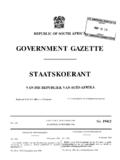Transcription of DETECTING BID RIGGING IN PUBLIC PROCUREMENT
1 Further information about the Guidelines for Fighting Bid RIGGING in PUBLIC PROCUREMENT , please contact:COMPETITION THE KEY TO PRODUCTIVITY AND GROWTH Ken DangerCompetition DivisionOECD2, Rue Andr Pascal75016 Paris FranceTel: +33 1 45 24 82 50 Fax: +33 1 45 24 96 CapobiancoCompetition DivisionOECD2, Rue Andr Pascal75016 Paris FranceTel: +33 1 45 24 98 08 Fax: +33 1 45 24 96 DETECTING BID RIGGING IN PUBLIC PROCUREMENTH elping governments to obtain best value for money21. HELPING GOVERNMENTS TO OBTAIN BEST VALUE FOR MONEYV igorous competition among suppliers helps governments to obtain the best value for money for the goods and services they procure. Conversely, when competition is curtailed for example when suppliers engage in bid RIGGING taxpayers money is wasted as governments pay more than a fair price.
2 Bid RIGGING occurs in all types of industries and circumstances, and in all parts of the world. When bid RIGGING impacts PUBLIC PROCUREMENT , it has the potential to cause great harm to taxpayers. One reason for this is that PUBLIC PROCUREMENT is often a large part of a nation s economy. In many OECD countries, it amounts to 15 per cent of the gross domestic product, and in most developing countries it is substantially more than this. Experience also shows that bid- RIGGING conspiracies can last decades and impact many markets. The United States Department of Justice, for example, found that more than 18 states were impacted by conspiracies to raise the price of milk sold to PUBLIC schools. The Netherlands government uncovered evidence that more than 600 firms had rigged bids in PUBLIC construction and proactive enforcement against bid RIGGING has promoted fair and free competition in Japanese PUBLIC PROCUREMENT markets.
3 This has saved significant PUBLIC resources and reduced contract prices by nearly 20 per cent in some cases as a result of restoring Takeshima, Chairman of the Japanese Fair Trade OECD has developed a methodology to help governments improve PUBLIC PROCUREMENT by fighting bid RIGGING . Drawing on the experience of more than 30 jurisdictions, the OECD Guidelines for Fighting Bid RIGGING in PUBLIC PROCUREMENT assist PROCUREMENT officials to detect bid RIGGING . The Guidelines help to identify: markets in which bid RIGGING is more likely to occur so that special precautions can be taken practices that PROCUREMENT agents can use to detect bid RIGGING suspicious pricing patterns suspicious statements, documents and behaviour by Guidelines provide a comprehensive strategy for DETECTING bid RIGGING .
4 They can be applied in a decentralized manner across government at both national and local levels. The Guidelines are an extremely useful tool for DETECTING bid RIGGING . PROCUREMENT agencies find them easy-to-use and tips from agencies have helped us uncover many bid- RIGGING schemes. They are an invaluable resource. Mariana Tavares de Araujo, Head of the Secretariat of Economic Law of the Ministry of Justice, WHAT IS BID RIGGING ?Bid RIGGING occurs when bidders agree among themselves to eliminate competition in the PROCUREMENT process, thereby denying the PUBLIC a fair price. Bidders can eliminate competition in PUBLIC PROCUREMENT in many simple ways, for example: A competitor agrees to submit a non-competitive bid that is too high to be accepted or contains terms that are unacceptable to the buyer.
5 A competitor agrees not to bid or to withdraw a bid from consideration. A competitor agrees to submit bids only in certain geographic areas or only to certain PUBLIC the schemes used by firms to rig bids vary, they all have one thing in common the bidders agree to eliminate competition so that prices are higher and the government pays more. 563. OECD GUIDELINES FOR DETECTING BID RIGGING IN PUBLIC PROCUREMENTThe OECD Guidelines include a Checklist for DETECTING Bid RIGGING in PUBLIC PROCUREMENT , which provides detailed information to help PROCUREMENT officials identify anti-competitive practices during the bidding process. Designed to be used by specialists and non-specialists alike, the Checklist highlights seven areas for active vigilance:1.
6 Look for markets that are more susceptible to bid RIGGING . The presence of certain factors increases the need for vigilance. Small number of bidders - The probability of bid RIGGING is higher if there are few bidders. Bid RIGGING requires bidders to reach an agreement that eliminates competition. It is also easier to reach an agreement if the same bidders are involved in repeated or simple products - The chances of bid RIGGING are greater if the products or services being purchased are standardized and simple, and do not change over time. Under these circumstances, it is easier to work out an agreement and have it last a long or no entry - If entry in a certain bidding market is costly, hard or time-consuming, firms in that market are protected from the competitive pressure of potential new entrants.
7 The protective barrier helps support bid- RIGGING Look for opportunities that the bidders have to communicate with each need to know and communicate with each other to reach an agreement. Once bidders know each other well enough to discuss bid RIGGING , they need a convenient location where they can talk. Of course, communications can occur by telephone, email, fax or letter, and they often do; however, many bid-riggers believe that they are less likely to leave evidence of their communications if they have face-to-face meetings. These meetings occur most often at, or in association with, trade association meetings, or other professional or social events. They are also likely to occur prior to the opening of the tender process.
8 3. Look for indications that the bidders have communicated with each RIGGING requires actual and often repeated communications between the bidders. PROCUREMENT officials may hear or come across statements indicating that information may have been shared, such as a bidder having knowledge of another bidder s pricing, or not expecting to be the low bidder, or perhaps when a bidder refers to industry or standard practices or prices. Sometimes PROCUREMENT agents can infer that bidders are communicating. For example, if one bidder picks up or submits bidding material for another firm, then some communication must have taken place between them. In other instances, a bidder may say something that indicates that certain non- PUBLIC information, or an answer to a question, was learned through talking to another Look for any relationships among the bidders after the successful bid is some cases, bidders may attempt to split the extra profit that is earned through bid RIGGING .
9 This is especially true if one large contract is involved. Sometimes the winning firm may pay the other bidders directly; however, the profit split can also be passed on through lucrative sub-contracts to do some of the work or to supply inputs to the project. Joint bids can also be used as a way to split Look for suspicious bidding may have devised a scheme that reveals itself as a pattern over the course of many bids. For example, there may be a pattern to the winner (A,B,C,A,B,C), or it may be that the same bidder always wins bids of a certain type or size, or that some bidders only bid in particular geographic areas. Perhaps a bidder never wins but keeps bidding; or a bidder wins whenever it bids, even if it bids rarely.
10 A bidder may show a pattern of submitting relatively high bids for some tender offers and relatively low bids for other, similar tender may be unusual. All bids may be unexpectedly high, or discounts or rebates may be unexpectedly small. Bids may also be different from previous, similar procurements, but the differences are unrelated to any change in the underlying economic conditions. Bid levels may change when a new bidder ( one who has not bid in the past) submits a bid. Pricing may not make sense when you consider transportation costs to different Look for unusual would expect the winning bidder to accept the contract, so it could be considered unusual , for example, if the winner chose not to accept it, or withdrew before the award was made.

















